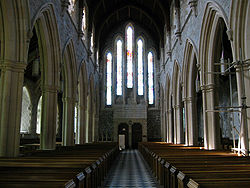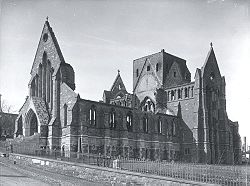.gif)
Cathedral of St. John the Baptist (St. John's)
Encyclopedia
The Cathedral of St. John the Baptist is located in the city of St. John's
, Newfoundland
. This parish in the Diocese of Eastern Newfoundland and Labrador was founded in 1699 in response to a petition drafted by the Anglican townsfolk of St. John's and sent to the Bishop of London
, the Rt. Rev. Henry Compton. In this petition, the people also requested help in the rebuilding of their church, which had been destroyed, along with the rest of the city, in 1696 by the French under the command of Pierre Le Moyne d'Iberville
. At least six wooden churches stood on or near this site and were destroyed by military operations during the wars between the French
and the British
which finally resulted in British control of North America
.
The first stone church was begun in 1843 under the direction of Aubrey George Spencer
, the first bishop of Newfoundland, but little progress was made on this relatively modest edifice beyond the laying of a cornerstone before Bishop Spencer resigned due to ill health.
 The present Cathedral was begun in 1847 by Edward Feild
The present Cathedral was begun in 1847 by Edward Feild
, the second bishop of Newfoundland. Bishop Feild commissioned plans from the leading Gothic Revival architect George Gilbert Scott
, who envisioned a more impressive cruciform structure with varied ornamentation in the twelfth-century English style. The Nave, built between 1847 and 1850, served as the entire Cathedral Church for 35 years. Scott's assistant, architect William Hay
, oversaw the nave's construction.
Construction on the choir and transept section did not commence until 1880 and was completed in September 1885, under the direction of James Butler Knill Kelly
. The additions to the nave gave the cathedral
the shape of a Latin cross and continued the era of Gothic Revival architecture
in the construction of nineteenth-century Anglican churches in Newfoundland.
 On July 8, 1892, the Cathedral was extensively damaged in The Great Fire of 1892. The roof timbers ignited, which caused the roof to collapse, bringing the clerestory walls and piers in the nave down with it. The intense heat caused the lead to melt in the glass windows, resulting in the complete destruction of all but two; the sole surviving window can be seen in the Sacristy. Restoration of the Cathedral commenced in 1893, again under Kelly's direction. By 1895, the Chancel
On July 8, 1892, the Cathedral was extensively damaged in The Great Fire of 1892. The roof timbers ignited, which caused the roof to collapse, bringing the clerestory walls and piers in the nave down with it. The intense heat caused the lead to melt in the glass windows, resulting in the complete destruction of all but two; the sole surviving window can be seen in the Sacristy. Restoration of the Cathedral commenced in 1893, again under Kelly's direction. By 1895, the Chancel
and Transepts had been rebuilt, while the Nave reached completion in 1905. A window in the restored Cathedral was dedicated to Kelly, who died in 1907.
The restored cathedral is renowned internationally as one of North America
's best ecclesiastical Gothic Revival structures. The church was re-consecrated in a service on September 21, 1905.
The Cathedral remains incomplete as the structure still lacks the spire which its designer, Scott, had envisaged. Although an engineering team has established that the proposed 150 feet (45.7 m) tower and steeple is structurally feasible, the cost was estimated to be $3,000,000. The clergy and parishioners remain committed to completing Scott's plans and are hopeful that they will see the spire erected.
The building has been designated as a Registered Heritage Structure by the Heritage Foundation of Newfoundland and Labrador
and is listed on the Canadian Register of Historic Places
.
St. John's, Newfoundland and Labrador
St. John's is the capital and largest city in Newfoundland and Labrador, and is the oldest English-founded city in North America. It is located on the eastern tip of the Avalon Peninsula on the island of Newfoundland. With a population of 192,326 as of July 1, 2010, the St...
, Newfoundland
Newfoundland and Labrador
Newfoundland and Labrador is the easternmost province of Canada. Situated in the country's Atlantic region, it incorporates the island of Newfoundland and mainland Labrador with a combined area of . As of April 2011, the province's estimated population is 508,400...
. This parish in the Diocese of Eastern Newfoundland and Labrador was founded in 1699 in response to a petition drafted by the Anglican townsfolk of St. John's and sent to the Bishop of London
Bishop of London
The Bishop of London is the ordinary of the Church of England Diocese of London in the Province of Canterbury.The diocese covers 458 km² of 17 boroughs of Greater London north of the River Thames and a small part of the County of Surrey...
, the Rt. Rev. Henry Compton. In this petition, the people also requested help in the rebuilding of their church, which had been destroyed, along with the rest of the city, in 1696 by the French under the command of Pierre Le Moyne d'Iberville
Pierre Le Moyne d'Iberville
Pierre Le Moyne d'Iberville pronounced as described in note] Pierre Le Moyne d'Iberville pronounced as described in note] Pierre Le Moyne d'Iberville pronounced as described in note] (16 July 1661 – 9 July 1702 (probable)was a soldier, ship captain, explorer, colonial administrator, knight of...
. At least six wooden churches stood on or near this site and were destroyed by military operations during the wars between the French
France
The French Republic , The French Republic , The French Republic , (commonly known as France , is a unitary semi-presidential republic in Western Europe with several overseas territories and islands located on other continents and in the Indian, Pacific, and Atlantic oceans. Metropolitan France...
and the British
United Kingdom
The United Kingdom of Great Britain and Northern IrelandIn the United Kingdom and Dependencies, other languages have been officially recognised as legitimate autochthonous languages under the European Charter for Regional or Minority Languages...
which finally resulted in British control of North America
North America
North America is a continent wholly within the Northern Hemisphere and almost wholly within the Western Hemisphere. It is also considered a northern subcontinent of the Americas...
.
The first stone church was begun in 1843 under the direction of Aubrey George Spencer
Aubrey George Spencer
Bishop Aubrey George Spencer was the first bishop of the Anglican Diocese of Newfoundland and Bermuda . He was also bishop of Jamaica.-Life:George Spencer was born at London, England...
, the first bishop of Newfoundland, but little progress was made on this relatively modest edifice beyond the laying of a cornerstone before Bishop Spencer resigned due to ill health.

Edward Feild
Bishop Edward Feild was a university tutor, university examiner, Anglican clergyman, inspector of schools and second Bishop of Newfoundland, born Worcester, England...
, the second bishop of Newfoundland. Bishop Feild commissioned plans from the leading Gothic Revival architect George Gilbert Scott
George Gilbert Scott
Sir George Gilbert Scott was an English architect of the Victorian Age, chiefly associated with the design, building and renovation of churches, cathedrals and workhouses...
, who envisioned a more impressive cruciform structure with varied ornamentation in the twelfth-century English style. The Nave, built between 1847 and 1850, served as the entire Cathedral Church for 35 years. Scott's assistant, architect William Hay
William Hay (architect)
William Hay was a Scottish architect who was actively working internationally from 1842 to 1887. A specialist in gothic architecture, he is primarily known for his work on several churches and cathedrals. His most famous structure is the Bermuda Cathedral in Hamilton, Bermuda which he designed in...
, oversaw the nave's construction.
Construction on the choir and transept section did not commence until 1880 and was completed in September 1885, under the direction of James Butler Knill Kelly
James Butler Knill Kelly
James Butler Knill Kelly was a Bishop of the Church of England active in the British colony of Newfoundland and in Scotland. Kelly was a participant in the first Lambeth Conference, which was a crucial step in the creation of the Anglican Communion...
. The additions to the nave gave the cathedral
Cathedral
A cathedral is a Christian church that contains the seat of a bishop...
the shape of a Latin cross and continued the era of Gothic Revival architecture
Architecture
Architecture is both the process and product of planning, designing and construction. Architectural works, in the material form of buildings, are often perceived as cultural and political symbols and as works of art...
in the construction of nineteenth-century Anglican churches in Newfoundland.

Chancel
In church architecture, the chancel is the space around the altar in the sanctuary at the liturgical east end of a traditional Christian church building...
and Transepts had been rebuilt, while the Nave reached completion in 1905. A window in the restored Cathedral was dedicated to Kelly, who died in 1907.
The restored cathedral is renowned internationally as one of North America
North America
North America is a continent wholly within the Northern Hemisphere and almost wholly within the Western Hemisphere. It is also considered a northern subcontinent of the Americas...
's best ecclesiastical Gothic Revival structures. The church was re-consecrated in a service on September 21, 1905.
The Cathedral remains incomplete as the structure still lacks the spire which its designer, Scott, had envisaged. Although an engineering team has established that the proposed 150 feet (45.7 m) tower and steeple is structurally feasible, the cost was estimated to be $3,000,000. The clergy and parishioners remain committed to completing Scott's plans and are hopeful that they will see the spire erected.
The building has been designated as a Registered Heritage Structure by the Heritage Foundation of Newfoundland and Labrador
Heritage Foundation of Newfoundland and Labrador
The Heritage Foundation of Newfoundland and Labrador is a non-profit organization which was established by the Provincial Government of Newfoundland and Labrador in 1984 to stimulate an understanding of and an appreciation for the architectural heritage of the province...
and is listed on the Canadian Register of Historic Places
Canadian Register of Historic Places
The Canadian Register of Historic Places is an online, searchable database that includes listings of historic places important to communities, cities, provinces, territories, and the nation...
.
Dimensions
The Cathedral stretches 200 feet (61 m) from the Great West Doors to the Sanctuary, with a 60 feet (18.3 m) wide nave and a maximum width of 99 feet (30.2 m) at the transepts. Where nave and transept cross, the floor-to-ceiling height is 57 feet (17.4 m); outside, the roof stands 80 feet (24.4 m) high at the ridge.Worship
The Cathedral offers Holy Communion on a daily basis. Services are held most frequently on Sundays, at 7:30 am, 8:00 am, 9:15 am, 11:00 am, and 6:30 pm.External links
- Anglican Cathedral of St. John the Baptist home page
- Mystery Worshipper Report at the Ship of Fools websiteShip of Fools (website)Ship of Fools is a UK-based Christian website. It was first launched as a magazine in 1977. The magazine folded in 1983 and was resurrected as a website on April Fool's Day, 1998. Subtitled "the magazine of Christian unrest", Ship of Fools pokes fun and asks critical questions about the Christian...

